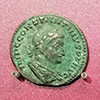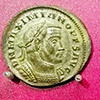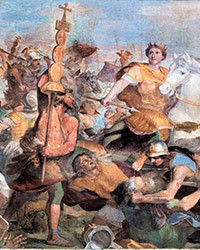
Reconstruction of the palace of Emperor Diocletian in Split (Croatia), pic.Wikipedia

Roman coin with the image of Emperor Constantine

Tetrarchs (Diocletian and Maximian, Galerius and Constantius, facade of St. Mark's Basilica, Venice, pic. Wikipedia

Maximian, Roman coin depicting Augustus in the years 286-305
The forty-year-old emperor Diocletian, who would be remembered as the founder of the enormous baths in Rome, took the throne in the year 284. For the previous fifty years, the empire had been in a state of chaos, which was further testified to by the continuous changes of emperors as a result of military revolts. It is enough to point out that between the assassination of Alexander Severus (235) and the beginning of the reign of Diocletian, five different emperors ruled in Rome. The crisis was further strengthened by the constant invasions of Franks, Alemanni, and Goths from the north and Persians from the south. Diocletian, who was conscious of these threats decided to introduce some reforms. One of these was the way future rulers of the empire would be chosen.
The forty-year-old emperor Diocletian, who would be remembered as the founder of the enormous baths in Rome, took the throne in the year 284. For the previous fifty years, the empire had been in a state of chaos, which was further testified to by the continuous changes of emperors as a result of military revolts. It is enough to point out that between the assassination of Alexander Severus (235) and the beginning of the reign of Diocletian, five different emperors ruled in Rome. The crisis was further strengthened by the constant invasions of Franks, Alemanni, and Goths from the north and Persians from the south. Diocletian, who was conscious of these threats decided to introduce some reforms. One of these was the way future rulers of the empire would be chosen.
Diocletian came from humble beginnings and was a soldier, whom the army chose to be emperor. Therefore, he knew firsthand how dangerous this procedure was for the continuation and stability of authority. It was necessary to develop a clearly defined formula for the selection of a ruler, who would be able to rule the enormous area of the then empire. Initially, Diocletian divided it into a western part and an eastern part. He himself, became the emperor of the East (the eastern shore of the Mediterranean Sea, including Egypt), while general Maximian was nominated to be the emperor of the West (his authority extended over Italy, Africa, and Spain). They controlled their own territories, but formally the empire had never been divided.
Nine years after his election, in face of revolts as well as threats on the borders of his state, Diocletian decided to take everything a step further and introduced tetrarchy, meaning the rule of four. It assumed the reign of two emperors (Augusti) and two Caesars who would be subject to them. The Augusti were to rule for only twenty years and they were to select the ablest Caesars. This was then a function for people who were in their prime, at the pinnacle of their physical and intellectual capabilities. This simple system was to prevent all kinds of usurpations. It did not take into account the right to inherit the throne and forced abdication after two decades of service (voluntary abdication). At the moment of the August's death or abdication, the throne was assumed by the Caesar, who then selected his successor. Diocletian reserved special status for himself (the so-called Augustus Senior), which would then be transferred to his successors. The friendship and cooperation of the Augusti and Caesars were to be guaranteed by marriages of individual family members. The imperial propaganda emphasized cooperation between individual emperors, which was testified to by the coins minted at that time. Another great example of such propaganda is the sculpture visible upon the façade of St. Mark's Basilica in Venice, depicting four rulers brought together in a gesture of brotherly love – two Augusti and two Caesars.
And at the beginning, all seemed well. Diocletian, tired of ruling, abdicated in the year 305 and retired to his palace in Split where he grew cabbages. Similarly, the second August, Maximian at the age of about fifty-five resigned from the throne. The place of the first Augustus (senior) was then – in accordance with the principle of tetrarchy – taken over by the first Eastern Caesar, Galerius, who had until then controlled the area around the Danube and the Balkans. Maximian was replaced as the Western Augustus by Constantius Chlorus, who controlled Gaul and Britannia. Both the new Augusti were to select new Caesars, which did indeed come to pass. Galerius selected Maximinus Daza, while Constantius Chlorus – Severus II. And all would have gone according to plan if it had not been for Constantine – the son of Constantius Chlorus, who after the death of his father (306) decided to assume power – against the principles of tetrarchy – and with the support of the army proclaimed himself as the new Augustus. Hoping for a compromise and fearing needless bloodshed, Galerius appointed Constantine as Caesar, while Severus as Augustus, but at that moment yet another candidate appeared, the son of the retired Maximian – Maxentius, who had also wanted to inherit the throne after his father. The latter supported his son, which led to skirmishes between the armies of Maxentius and Severus II, who eventually capitulated and then was either murdered or – as was customary – forced to commit suicide by his rival. Ultimately after the Battle of the Milvian Bridge, which took place in 312 between Maxentius and Constantine, only three Augusti remained in the political arena: Constantine in the West and Licinius and Maximinus Daza in the East. In the following years, only two fought for power (Constantine and Licinius), while in the end, in the year 324 a single ruler once again reigned in the empire – Constantine referred to as Great by posterity.
And thus tetrarchy which was to be an ideal way to halt anarchy lasted a mere twenty years and rapidly showed its shortcomings since the ambitions and interests of individual generals proved stronger than the pipe dreams of Emperor Diocletian about brotherly coexistence of all rulers for the good of the empire.
















